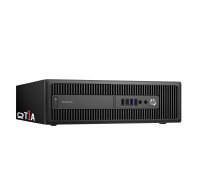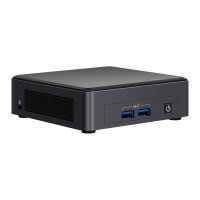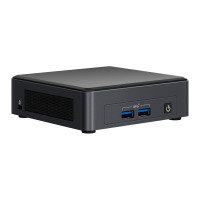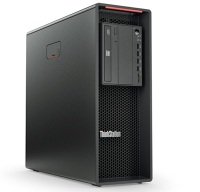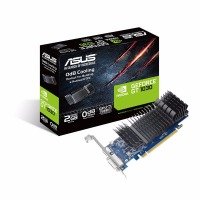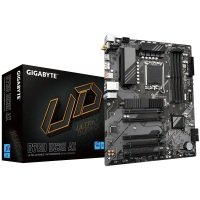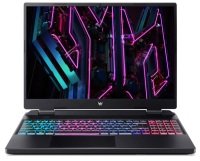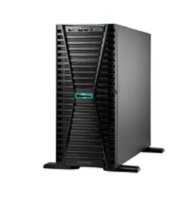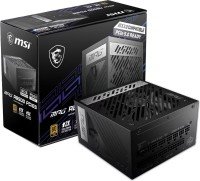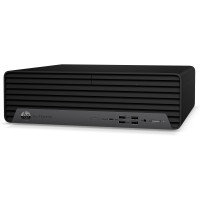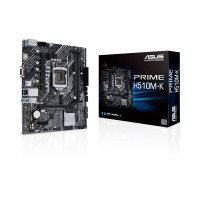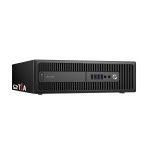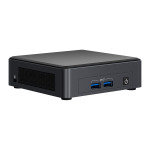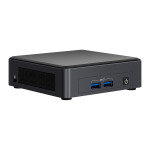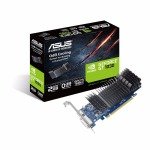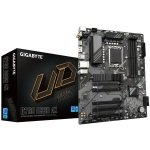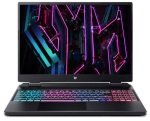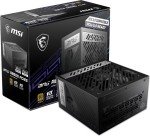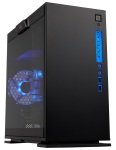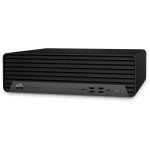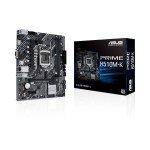91 search results for “graphics cards intel”
Refurbished HP Elitedesk 800 G2 Mini Desktop PC - Intel Core i5-6500
- Processor: Intel Core i5-6500 3.20 GHz
- Graphics Card: Intel HD Graphics 530
- RAM | Storage: 8 GB RAM, 240 GB SSD
- Operating System: Windows 10 Pro
SKU: D-HPED800G2-MU-T007
£
180.62
inc.
vat
£ 150.51 ex.
vat
0% Interest offers available
EXDISPLAY Intel NUC 11 Tiger Canyon Core i7-1185G7 Mini PC Slim Barebone
- Intel Core i7-1185G7
- DDR4-3200
- M.2 SSD
SKU: EBR1-BNUC11TNKV70000
£
449.99
inc.
vat
£ 374.99 ex.
vat
0% Interest offers available
Intel NUC 11 Tiger Canyon Core i7-1185G7 Mini PC Slim Barebone
- Intel Core i7-1185G7
- DDR4-3200
- M.2 SSD
SKU: BNUC11TNKV70000
£
469.98
inc.
vat
£ 391.65 ex.
vat
0% Interest offers available
Refurbished Lenovo Thinkcentre M70q Tiny Desktop PC - Intel Core i5-11400T
- Processor: Intel Core i5-11400T
- Graphics Card: Intel UHD Graphics
- RAM | Storage: 8GB DDR4, 256GB NVMe SSD
- Operating System: Windows 10 Pro
- Warranty: 2 Year
SKU: D-M70Q-UK-T001
£
329.99
inc.
vat
£ 274.99 ex.
vat
0% Interest offers available
Refurbished Lenovo ThinkStation P520 Desktop PC Tower - Intel Xeon W-2133, NVIDIA Quadro P2200
- Processor: Intel Xeon W-2133
- Graphics Card: NVIDIA Quadro P2200
- RAM | Storage: 8GB DDR4, 512GB SSD
- Operating System: Windows 10 Pro
- Warranty: 2 Years
SKU: D-P520-MU-Z004
£
439.98
inc.
vat
£ 366.65 ex.
vat
0% Interest offers available
Asus NVIDIA GeForce GT 1030 Graphics Card - 2GB
- Memory Size / Type: 2GB GDDR5
- Boost Clock: 1468 MHz
- Interface: HDMI and DVI
- Warranty: 3 Years
SKU: GT1030-SL-2G-BRK
£
81.48
inc.
vat
£ 67.90 ex.
vat
Gigabyte B760 DS3H AX ATX Motherboard
- Socket LGA 1700
- Intel 13th Generation
- DDR5 Support
- ATX Form Factor
SKU: B760 DS3H AX
£
164.99
inc.
vat
£ 137.49 ex.
vat
0% Interest offers available
Acer Predator Helios 16 Inch Gaming Laptop - Intel Core i9-13900HX, RTX 4070 8GB
- Screen: 16 Inch IPS WQXGA
- RAM / Storage: 16GB / 1TB SSD
- Operating System: Windows 11 Home
- Processor: Intel Core i9-13900HX
- Battery Life: Up to 6 hours
SKU: NH.QJREK.00A
£
2,049.96
inc.
vat
£ 1,708.30 ex.
vat
0% Interest offers available
HPE ProLiant ML110 Gen11 server Tower (4.5U) Intel Xeon Bronze 1.8 GHz 16 GB DDR5-SDRAM
- Server Product Advice:
- 01430 433 671 or [email protected]
- RAID levels: 0, 1, 5, 10
- Hot-Plug support: Yes
- Chassis type: Tower (4.5U)
SKU: P55639-421
£
2,415.32
inc.
vat
£ 2,012.76 ex.
vat
0% Interest offers available
MSI MPG A850G PCIe5 ATX 3.0 850W Modular Power Supply 80 Plus Gold
- Supports Nvidia® GeForce RTX® 40 Series graphics cards
- Full modular design
- Flat cables
- 80 Plus Gold certified for high efficiency
SKU: MPG A850G PCIE5
£
139.98
inc.
vat
£ 116.65 ex.
vat
0% Interest offers available
HP Victus 16 Inch Gaming Laptop - Intel Core i5 13500H - RTX 3050
- Screen: 16.1 Inch Full HD
- RAM / Storage: 16GB DDR5 RAM & 512GB SSD
- Operating System: Windows 11 Home 64-bit
- Processor: Intel Core i5 13500H
SKU: 876Z5EA#ABU
£
996.99
inc.
vat
£ 830.82 ex.
vat
0% Interest offers available
Medion Engineer X31 Gaming PC - Intel Core i5-12400, RTX 4060 Ti
- Processor: Intel Core i5-12400
- Graphics Card: NVIDIA GeForce RTX 4060 Ti
- RAM | Storage: 16GB DDR4, 512GB NVMe SSD
- Operating System: Windows 11 Home
- Warranty: 2 Year
SKU: 10025110
£
1,049.99
inc.
vat
£ 874.99 ex.
vat
0% Interest offers available
Refurbished HP Elitedesk 800 G4 Mini PC Desktop - Intel Core i5-8500
- Processor: Intel Core i5-8500
- Graphics Card:Intel UHD Graphics 630
- RAM | Storage: 8GB RAM, 256 GB SSD
- Operating System: Windows 10 Pro
SKU: D-HPED800G4-MU-T002
£
207.80
inc.
vat
£ 173.16 ex.
vat
0% Interest offers available
Refurbished HP Elitedesk 800 G4 Mini PC Desktop - Intel Core i5 8500T
- Processor: Intel R CoreTM i5-8500t
- Graphics Card: Intel UHD Graphics 630
- RAM | Storage: 8GB, 256 GB SSD
- Operating System: Windows 10 Pro
SKU: D-HPED800G4-MU-T001
£
288.99
inc.
vat
£ 240.82 ex.
vat
0% Interest offers available
ASUS PRIME H510M-K mATX Motherboard
- Socket LGA 1200
- 10th/ 11th Generation Intel
- DDR4 Support
- mATX Form Factor
SKU: PRIME H510M-K
£
72.99
inc.
vat
£ 60.82 ex.
vat
Refurbished HP Elitedesk 800 G2 Mini Desktop PC - Intel Core i5-6500
- Processor: Intel Core i5-6500 3.20 GHz
- Graphics Card: Intel HD Graphics 530
- RAM | Storage: 8 GB RAM, 240 GB SSD
- Operating System: Windows 10 Pro
£
180.62
inc.
vat
£ 150.51 ex.
vat
0% Interest offers available
EXDISPLAY Intel NUC 11 Tiger Canyon Core i7-1185G7 Mini PC Slim Barebone
- Intel Core i7-1185G7
- DDR4-3200
- M.2 SSD
£
449.99
inc.
vat
£ 374.99 ex.
vat
0% Interest offers available
Intel NUC 11 Tiger Canyon Core i7-1185G7 Mini PC Slim Barebone
- Intel Core i7-1185G7
- DDR4-3200
- M.2 SSD
£
469.98
inc.
vat
£ 391.65 ex.
vat
0% Interest offers available
Refurbished Lenovo Thinkcentre M70q Tiny Desktop PC - Intel Core i5-11400T
- Processor: Intel Core i5-11400T
- Graphics Card: Intel UHD Graphics
- RAM | Storage: 8GB DDR4, 256GB NVMe SSD
- Operating System: Windows 10 Pro
- Warranty: 2 Year
£
329.99
inc.
vat
£ 274.99 ex.
vat
0% Interest offers available
Refurbished Lenovo ThinkStation P520 Desktop PC Tower - Intel Xeon W-2133, NVIDIA Quadro P2200
- Processor: Intel Xeon W-2133
- Graphics Card: NVIDIA Quadro P2200
- RAM | Storage: 8GB DDR4, 512GB SSD
- Operating System: Windows 10 Pro
- Warranty: 2 Years
£
439.98
inc.
vat
£ 366.65 ex.
vat
0% Interest offers available
Asus NVIDIA GeForce GT 1030 Graphics Card - 2GB
- Memory Size / Type: 2GB GDDR5
- Boost Clock: 1468 MHz
- Interface: HDMI and DVI
- Warranty: 3 Years
£
81.48
inc.
vat
£ 67.90 ex.
vat
Gigabyte B760 DS3H AX ATX Motherboard
- Socket LGA 1700
- Intel 13th Generation
- DDR5 Support
- ATX Form Factor
£
164.99
inc.
vat
£ 137.49 ex.
vat
0% Interest offers available
Acer Predator Helios 16 Inch Gaming Laptop - Intel Core i9-13900HX, RTX 4070 8GB
- Screen: 16 Inch IPS WQXGA
- RAM / Storage: 16GB / 1TB SSD
- Operating System: Windows 11 Home
- Processor: Intel Core i9-13900HX
- Battery Life: Up to 6 hours
£
2,049.96
inc.
vat
£ 1,708.30 ex.
vat
0% Interest offers available
HPE ProLiant ML110 Gen11 server Tower (4.5U) Intel Xeon Bronze 1.8 GHz 16 GB DDR5-SDRAM
- Server Product Advice:
- 01430 433 671 or [email protected]
- RAID levels: 0, 1, 5, 10
- Hot-Plug support: Yes
- Chassis type: Tower (4.5U)
£
2,415.32
inc.
vat
£ 2,012.76 ex.
vat
0% Interest offers available
MSI MPG A850G PCIe5 ATX 3.0 850W Modular Power Supply 80 Plus Gold
- Supports Nvidia® GeForce RTX® 40 Series graphics cards
- Full modular design
- Flat cables
- 80 Plus Gold certified for high efficiency
£
139.98
inc.
vat
£ 116.65 ex.
vat
0% Interest offers available
HP Victus 16 Inch Gaming Laptop - Intel Core i5 13500H - RTX 3050
- Screen: 16.1 Inch Full HD
- RAM / Storage: 16GB DDR5 RAM & 512GB SSD
- Operating System: Windows 11 Home 64-bit
- Processor: Intel Core i5 13500H
£
996.99
inc.
vat
£ 830.82 ex.
vat
0% Interest offers available
Medion Engineer X31 Gaming PC - Intel Core i5-12400, RTX 4060 Ti
- Processor: Intel Core i5-12400
- Graphics Card: NVIDIA GeForce RTX 4060 Ti
- RAM | Storage: 16GB DDR4, 512GB NVMe SSD
- Operating System: Windows 11 Home
- Warranty: 2 Year
£
1,049.99
inc.
vat
£ 874.99 ex.
vat
0% Interest offers available
Refurbished HP Elitedesk 800 G4 Mini PC Desktop - Intel Core i5-8500
- Processor: Intel Core i5-8500
- Graphics Card:Intel UHD Graphics 630
- RAM | Storage: 8GB RAM, 256 GB SSD
- Operating System: Windows 10 Pro
£
207.80
inc.
vat
£ 173.16 ex.
vat
0% Interest offers available
Refurbished HP Elitedesk 800 G4 Mini PC Desktop - Intel Core i5 8500T
- Processor: Intel R CoreTM i5-8500t
- Graphics Card: Intel UHD Graphics 630
- RAM | Storage: 8GB, 256 GB SSD
- Operating System: Windows 10 Pro
£
288.99
inc.
vat
£ 240.82 ex.
vat
0% Interest offers available
ASUS PRIME H510M-K mATX Motherboard
- Socket LGA 1200
- 10th/ 11th Generation Intel
- DDR4 Support
- mATX Form Factor
£
72.99
inc.
vat
£ 60.82 ex.
vat

